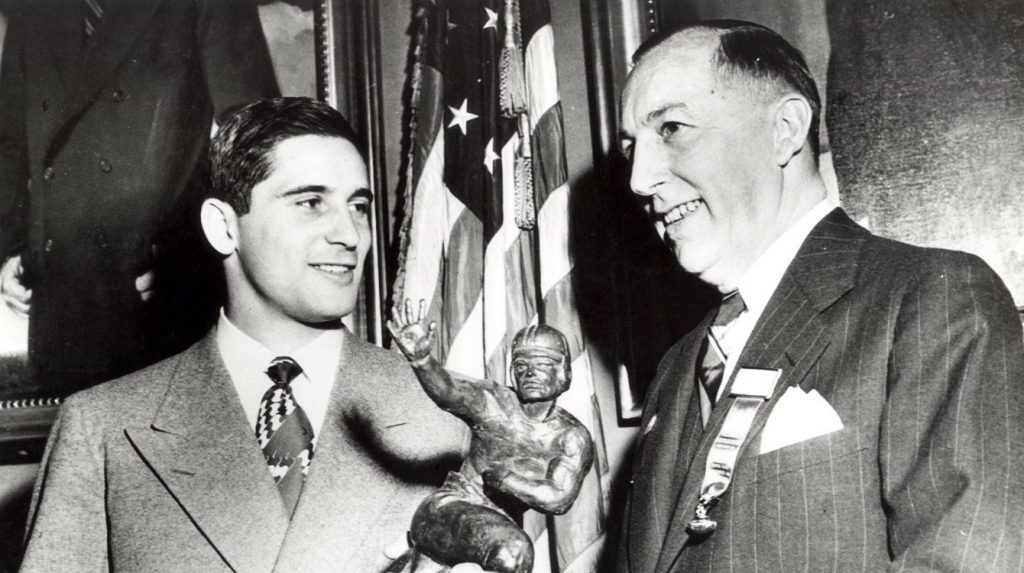
Did you know? The 1940s Heismans

Here’s the latest in a series of trivia tidbits about Heisman Trophy winners. Today, the Heismans from the 1940s.
Did you know …
… in 1941, Bruce Smith became the first Heisman winner from the University of Minnesota. The former Golden Gopher great was only 47 when he was diagnosed with cancer in the spring of 1967. The cancer quickly ravaged Smith’s body as he lost over 100 pounds in a matter of months. Despite his weakened condition, Smith courageously accompanied Reverend William Cantwell, comforting and entertaining youngsters also suffering from the disease. Smith ultimately succumbed to the disease in August of 1967, but only after surviving far longer than doctors had predicted. Smith’s wife Gloria later said, “He forced himself to live three months longer than any medical man said he would because he wanted to spend the summer with his kids.” Reverend Cantwell, who was unaware of Smith’s athletic accomplishments, nominated Smith for sainthood in the Roman Catholic Church and continued to invoke his intercession on behalf of young cancer patients long after his death.
… Smith was also the first Heisman winner to have his number retired when the University of Minnesota placed his “No. 54” jersey in their trophy case.
… 1942 Heisman winner, Frank Sinkwich from Georgia, was in the Marine Corps when he won his Heisman, but he was discharged soon after due to flat feet.
… Frank Sinkwich did not receive a trophy because wartime restrictions precluded the use of the metal necessary to create one. Therefore, Sinkwich and all other wartime winners received certificates to honor their accomplishments instead. Once the war was over and the restrictions were lifted, the actual trophies were created and given to the winners.
… In 1943, Angelo Bertelli was not able to attend the initial trophy presentation in early December due to his Marine Corps training. The ceremony was rescheduled and Bertelli accepted his Heisman on January 12, 1944 in New York City.
… 1944 Heisman winner Les Horvath of Ohio State is one of two dentists to win the award. Billy Cannon of Louisiana State is the other.
…1945 Heisman winner Felix ‘Doc’ Blanchard was known as Army’s “Mr. Inside,” while his teammate and 1946 Heisman winner, Glenn Davis was known as, “Mr. Outside.” Together the two formed one of the most lethal rushing attacks in college football history and from 1944 to 1946 they lead Army to a 27-0-1 record.
… Glenn Davis and Doc Blanchard are the only Heisman winners to appear in a film together. They played themselves in “The Spirit of West Point.”
… Doc Blanchard is not only the first college junior to win the Heisman Trophy, but also the first college football player to win the James E. Sullivan Award, given to America’s best amateur athlete.
… Doc Blanchard, who remained in the military and served with distinction, was selected as an honor guard for President Franklin Delano Roosevelt’s funeral in April 1945.
… Glenn Davis was pursued by baseball’s Brooklyn Dodgers, but stuck with football and played with the NFL’s Los Angeles Rams before his career was cut short due to a knee injury suffered in 1952.
… Glenn Davis was briefly married to actress Terry Moore and was also engaged to actress Elizabeth Taylor.
… The fabled scoreless tie between Army and Notre Dame at Yankee Stadium in 1946 featured four Heisman winners. Army’s Doc Blanchard and Glenn Davis faced off against Notre Dame’s John Lujack, while Notre Dame end Leon Hart watched from the sidelines.
… 1947 Heisman winner John Lujack of Notre Dame was the first former professional football player to become a color analyst on television. 1940 Heisman winner Tom Harmon was the first to do so on radio.



